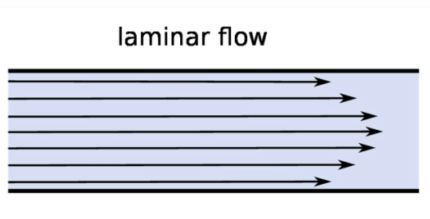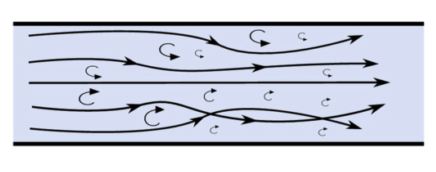What Is Lamina Flow?
In fluid dynamics, laminar flow also referred to as streamline fluid flow, is a type of fluid flow in which the fluid travels smoothly or in regular paths. In laminar flow, the velocity, pressure and other flow properties at each point in the fluid remain constant. The motion of particles of the fluid is very orderly with all particles moving in straight lines parallel to the pipe walls.
Lamina flow is common only in cases in which the flow channel is relatively small, the fluid is moving slowly and its viscosity is relatively high. At low velocities, the fluid tends to flow without lateral mixing and adjacent layers slide past one another. There are no cross-currents perpendicular to the direction of flow, no eddies or swirls of fluids. A perfect example of lamina flow is the flow of any liquid within a pipe or tube with small diameter, flow of honey or thick syrup from a bottle.

What You Need To Know About Lamina Flow
- In lamina flow of a fluid, the various layers of the fluid slide parallel to each other without any disturbance, interference or intermixing. Lamina flow can also be referred to as streamline flow.
- In the laminar flow, the fluid layers move in straight line or is considered to be moving in layers or laminae.
- Generally, laminar flow occurs in the fluid flowing with low velocity.
- Shear stress in laminar flow depends only on the viscosity of the fluid and independent of the density.
- Lamina flow usually occurs in the small diameter pipes in which fluid flows with low velocity.
- The fluid flow is regular i.e there is no mixing of adjacent layers of the fluid and they move parallel to each other also with the walls of the pipe. The flow appears to be smooth without any mixing on a macroscopic scale between adjacent layers, even though mixing on molecular scale may exist.
- Usually Reynolds number is used as a criterion for characterizing the flow as laminar or turbulent. The fluid is laminar when the value of Reynolds number (Re) is less than 200.
- A fluid with a streamline flow possesses a small amount of kinetic energy.
- A perfect example of lamina flow is the flow of any liquid within a pipe or tube with small diameter, flow of honey or thick syrup from a bottle.
- Lamina flow is characterized by the absence of cross currents, eddies and swirls.
Turbulent Flow
In fluid dynamics, turbulent flow is a type of flow in which fluid moves randomly in irregular or zigzag manner. Turbulent flow is turbulent and chaotic in nature, the flow is characterized by the presence of eddies, tiny whirlpools, swirls and waves. In turbulent flow, the speed of the fluid at a point is continuously undergoing changes in both magnitude and direction. The adjacent layers of the fluid get mixed with each other and there is a large amount of friction between the boundaries of these layers.

Fluids that are in turbulent flow have a substantial amount of kinetic energy within them. As long as this energy persists, the flow will continue to be turbulent and irregular. Once the energy is used up, the flow transitions to a laminar flow state. The velocity of a turbulent fluid is typically high equalizing as it transitions to a laminar flow state.
Common examples of turbulent are blood flow in arteries, oil transport in pipelines, lava flow, atmosphere and ocean currents, flow through pumps and turbines, and the flow in boat wakes and around aircraft-wing tips.
What determines if the flow of a fluid is classified as laminar or turbulent is the flow’s Reynolds number. Reynolds Number is a calculation that defines the flow of a fluid as being the ratio of inertial forces to the viscous forces. If the Reynolds number is calculated at less than 2300, the flow of the fluid is considered laminar whereas if the Reynolds number is greater than 4000, the fluid’s flow is considered as turbulent.
What You Need To Know About Lamina Flow
- Turbulent flow is turbulent and chaotic in nature. The adjacent layers of the fluid get mixed with each other and there is a large amount of friction between the boundaries of these layers.
- In turbulent flow, the fluid layers do not move in straight line. They move randomly in zigzag manner.
- Turbulent flow occurs in the fluid flowing with high velocity.
- Shear stress in the turbulent flow depends upon the density of the fluid.
- Turbulent flow occurs in large diameter pipes in which fluid flows with high velocity.
- The fluid flow is irregular i.e there is mixing of adjacent layers of the fluid with each other and they do not move parallel to each other and also with the walls of the pipe.
- Usually Reynolds number is used as a criterion for characterizing the flow as laminar or turbulent. The fluid flow is turbulent when the value of Reynolds number (Re) is greater than 4000.
- A fluid that is flowing turbulently possesses a large amount of kinetic energy.
- A perfect example of turbulent fluid flow would be ocean currents and waves, oil transport in pipelines, blood flow in arteries, lava flow, flow through pumps and turbines, flow in boat wakes and around aircraft-wings etc.
- Turbulent flow is characterized by the presence of eddies, tiny whirlpools, swirls and waves.
Difference Between Lamina And Turbulent Flow In Tabular Form
| BASIS OF COMPARISON | LAMINA FLOW | TURBULENT FLOW |
| Description | In lamina flow of a fluid, the various layers of the fluid slide parallel to each other without any disturbance, interference or intermixing. Lamina flow can also be referred to as streamline flow. | Turbulent flow is turbulent and chaotic in nature. The adjacent layers of the fluid get mixed with each other and there is a large amount of friction between the boundaries of these layers. |
| Fluid Layer Movement | The fluid layers move in straight line or is considered to be moving in layers or laminae. | The fluid layers do not move in straight line. They move randomly in zigzag manner. |
| Occurrence | Occurs in the fluid flowing with low velocity. | Occurs in the fluid flowing with high velocity. |
| Shear Stress | Shear stress in laminar flow depends only on the viscosity of the fluid and independent of the density. | Shear stress in the turbulent flow depends upon the density of the fluid. |
| Velocity Of The Flow | Occurs in the small diameter pipes in which fluid flows with low velocity. | Occurs in large diameter pipes in which fluid flows with high velocity. |
| Fluid Flow | The fluid flow is regular i.e there is no mixing of adjacent layers of the fluid and they move parallel to each other also with the walls of the pipe. The flow appears to be smooth without any mixing on a macroscopic scale between adjacent layers, even though mixing on molecular scale may exist. | The fluid flow is irregular i.e there is mixing of adjacent layers of the fluid with each other and they do not move parallel to each other and also with the walls of the pipe. |
| Reynolds Number | The fluid is laminar when the value of Reynolds number (Re) is less than 200. | The fluid flow is turbulent when the value of Reynolds number (Re) is greater than 4000. |
| Example | The flow of any liquid within a pipe or tube with small diameter, flow of honey or thick syrup from a bottle. | Ocean currents and waves, oil transport in pipelines, blood flow in arteries, lava flow, flow through pumps and turbines, flow in boat wakes and around aircraft-wings etc. |
| Common Feature | Characterized by the absence of cross currents, eddies and swirls. | Characterized by the presence of eddies, tiny whirlpools, swirls and waves. |
Comments are closed.